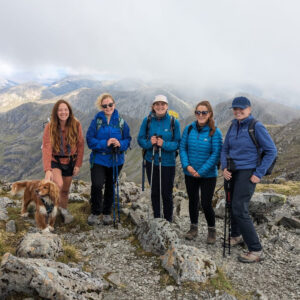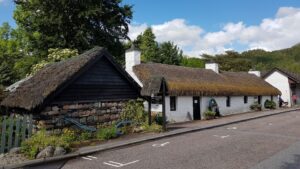Creating a Culture of Fundraising
Fundraising Consultant Katie Mullen explains how new events, income streams, strategies, and management tools have helped to build the financial resilience of Glencoe Folk Museum.

The project
We’ve been working hard to secure the future of Glencoe Folk Museum. We’re undertaking a major redevelopment of the museum which will transform the site into a modern, vibrant community venue and tourist attraction.
I’ve been recruited by Glencoe Folk Museum to support this redevelopment project by lending my expertise and creating a culture of fundraising at the organisation. I’m helping to set strategic goals, identify new fundraising methods, train staff and volunteers, and support the museum’s financial security.
My work with the museum team has led to an overhaul of the museum’s fundraising strategy, the creation of ethical fundraising policies, and training for staff and volunteers on how to identify new opportunities for income generation. We’ve introduced new Customer Relationship Management software to keep track of current and potential donors, and have identified previously untapped sources of funding from major donors, legacies, community appeals, The Giving Lottery, online raffles, and events.
Thanks to these changes, Glencoe Folk Museum now has clear goals for future fundraising, more diverse income streams, and a stronger base of financial support. This will help us to realise our vision of a new building for the museum site: a sustainable space with more room for displays and better conditions for the preservation of the 5,000 artefacts in our care.
“Working at Glencoe Folk Museum has been a delight. The staff and trustees do everything they can to support the fundraising strategy. We are starting to see real growth in several income streams, and have a solid plan for continuing this growth over the next four years. "I am so pleased that the project has been a success, as this is a wonderful museum which should be enjoyed by as many people as possible, for as long as possible.”
Katie Mullen, Fundraising Consultant
Successes
- Sharing fundraising expertise with other heritage and local organisations, including appearing on a fundraising panel at the Museums & Heritage Highland conference and producing a feature for Creative Scotland.
- Organising successful fundraising events, including a sponsored hike.
- Supporting the museum’s Learning and Engagement Officer to build relationships with other local organisations.
- Securing pro bono support from the University of the Highlands and Islands to 3D scan artefacts which will be replicated to use as exciting new donation boxes in the redeveloped museum.
- Developing a glossy Supporter’s Proposal which outlines the benefits of supporting us and introduces sponsorship goals such as funding a schools session, conserving an artefact, and sponsoring a display case.
Challenges
- It’s a lot of work to do on a part-time basis!
- The question of how to ensure the new fundraising programme would be sustainable at the end of the funded post. This was addressed by including fundraising costs in new grant applications and extending the Fundraising Consultant post.
- Fundraising in a challenging climate, particularly with the cost-of-living crisis. We addressed this by stressing the importance of museums and community heritage and adding a rewards scheme for donations which included a wall of sponsors.
- Grant funders are oversubscribed and their investments are down over the past few years, so they have less to give. This makes it harder to secure grant funding.
- There aren’t many medium or large businesses locally, which makes it difficult to develop corporate fundraising; however, we’re attending Lochaber Chamber networking events to try and build relationships.

Impact
- A lot of funding has been raised!
- The transformation of the museum’s internal record-keeping of current and potential funders and donors. This has enabled fresh approaches to be made with greater ease.
- Through training and helping staff and volunteers develop confidence in pursuing new funding sources, a culture of fundraising has been embedded throughout the museum.
- We have begun to develop a variety of income streams and now give our supporters a range of ways in which they can support us, meaning that there is something for everyone, and that we aren’t overly reliant on any one source of income.
- Through the updated strategies and training delivered the museum now has a much more clear and less daunting path to long-term financial security.
Guidance
At first I was more focussed on asking for funds for our schools and outreach work with children as I thought that this would ‘pull on the heartstrings’ and get donations.
As fundraisers, we’re trained that our campaigns should be about “people first” where possible… but we are also taught to get to know our audience. It turns out the latter is much more important.
Our donation requests that focussed on specific artefacts at the Museum have been much more successful. It may seem obvious… but people love the museum because they love the history!
So I learned to change the way I think about fundraising campaigns, and lean into this as what our supporters are really interested in.
- Look beyond the heritage sector for ideas for your fundraising, and then adapt them to make them relevant for your organisation.
- Work closely with your education and development staff – together you can create some brilliant activities that can serve as both community learning and fundraising events.
- Give your supporters a number of different ways to support you, such as adopt an object, competitions, event tickets, and lotteries.
- Attend local networking events to build relationships with other organisations and businesses – this could lead to profitable corporate partnerships (it just take a few years of graft!).
Additional information
Email: the Glencoe Folk Museum fundraising team
Read: “Connecting Scots to our Highland Heritage”, a Glencoe Folk Museum case study on the Our Creative Voice website
Watch: “Fundraising in Small, Rural Museums”, a Rural Museums Network presentation by Katie Mullen